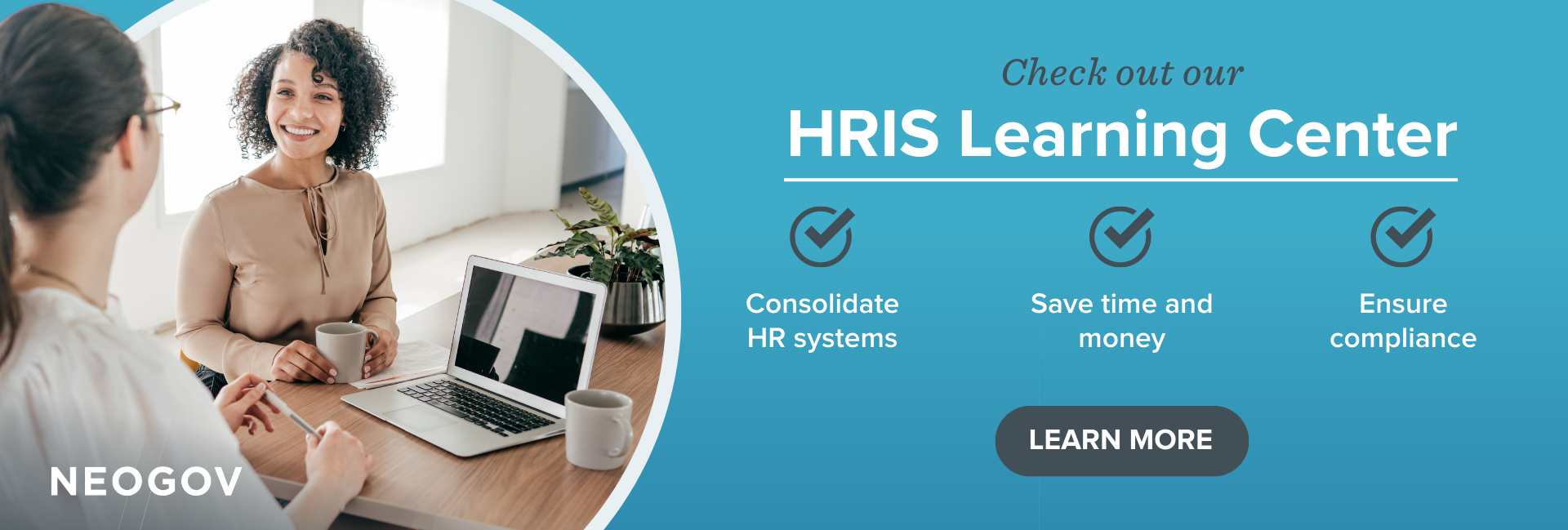Learn how core HR software helps public sector organizations improve four core HR functions.
Article Highlights:
As an HR professional, you drive organizational success by coordinating critical human resources processes, from onboarding to performance management. These activities are known as core HR functions, including information and tools you rely on to complete them.
In government, the complexity of your administrative duties requires unique solutions that often can’t be met with just one system, so you use multiple systems to manage workflows, organize details, and update employee data. For example, you might use software to maintain time and attendance records, Excel spreadsheets to track employee training progress, and paper fliers to notify employees about open enrollment periods.
But these decentralized systems make it impossible to ensure systematic, efficient core HR processes. You inevitably struggle to keep data up-to-date, spend precious time entering details in multiple places, and regularly find data inaccuracies. The complex needs of the public sector only make it more challenging to process employee requests and stay on top of workloads.
Fortunately, there’s a straightforward solution to your organization’s disjointed approach: a Human Resources Information System (HRIS), also known as core HR software. In this article, you’ll learn more about core HR functions and how an HRIS can help you centralize employee information, automate workflows, and empower employees.
What are Core HR Functions?
Before we discuss improving your processes with an HRIS, let’s clarify what we mean by “core HR functions.” We describe the four critical activities that public sector HR departments manage below.
Talent management
Your public sector organization couldn’t provide a high level of service to residents without talented employees. HR departments coordinate the recruitment and selection of employees by organizing and reviewing applications, scheduling interviews, and processing new hire paperwork, among other things. Upon hire, HR professionals also manage the onboarding process to ensure these employees have the knowledge and information they need to succeed in their new roles.
Administrative employee data management
HR professionals must stay highly organized as they maintain immense amounts of confidential data for employees and organizations. The HR team must ensure this personally-identifiable information remains accurate and secure as they administer employee benefit plans, coordinate with the payroll department, and manage time and attendance information, among other tasks.
Additionally, your HR department creates, updates, and enforces organizational policies to ensure all employees remain compliant. A critical component of this work is tracking and organizing signed documents indicating employees received this information.
Performance management
In addition to finding talent and managing employee data, HR professionals oversee the employee performance evaluation process. HR professionals may create or update the evaluation forms that employees use, coordinate conversations between supervisors and employees, and store all completed performance evaluation records for future reference.
Learning and development
Finally, HR professionals are responsible for cultivating a robust learning and development program. As part of this core HR function, HR professionals create and administer courses to employees that help fill skill gaps, support career growth, and ensure compliance with organizational policies. Then, HR professionals track course progress and completion to ensure employees receive all of your agency’s required training.
How Can You Improve Your Core HR Processes?
Because each activity discussed above requires different workflows, processes, and data, it can be overwhelming for HR professionals to juggle these critical HR functions. Investing in a core HR software system (often called an HRIS) is one of the best ways to simplify these workstreams and improve core HR processes.
An HRIS integrates critical data and streamlines workflows across all your HR functions – from payroll to performance evaluation. Below, we discuss the specific HRIS features that make this possible.
Centralize core HR in one integrated system
Public sector organizations often rely on multiple HR systems to complete their core functions. In contrast to this common yet inefficient approach, an HRIS provides one centralized location to manage your organization’s human resources tasks.
Because all your HR functions are managed in one system, you can more efficiently complete HR, payroll, benefits administration, and time and attendance tasks. For example, time and attendance data automatically feeds into payroll calculations, making it easier to meet complex pay and time rules and ensure the timely distribution of paychecks.
HR professionals can also use a centralized HRIS to:
- Manage employee information, including confidential data like Social Security numbers.
- Process HR requests, like reasonable accommodations.
- Authorize approvals in one place, such as approving FMLA leave.
Plus, this integration reduces the need for duplicate data entry. Rather than involving HR whenever an employee’s data changes – whether the employee gets married, changes addresses, has a child, or experiences another life event – the HRIS quickly synchronizes changes across the entire system.
As a result, HR professionals have more time and flexibility to center their workday around the activities that require their professional expertise – not just their fingers on a keyboard.
Leverage automation and workflows
Another way an HRIS improves your core HR functions is by automating human resources tasks across the organization. You can use an HRIS to send automated notifications to employees that let them know when it’s time to complete annual activities, including:
- Benefit elections during open enrollment periods.
- Self-evaluations during the performance review process.
- Address updates before the organization sends out W2 forms.
You can even use an HRIS to create approval workflows that automatically begin when an employee updates their information or submits a request. For example, HR can quickly review an employee’s available PTO, view their request for time off, and approve the request all on the same screen.
Core HR software automatically updates this information in real-time, from hours worked to PTO banks and other information changes. In addition to promoting transparency with managers, this automation saves time and reduces administrative stress for employees and supervisors alike.
Use an employee self-service portal
Employee self-service allows employees to log into a portal and track or update critical information. For example, employees might log in to change their tax withholdings or update their insurance beneficiaries.
As a result, self-service drastically reduces pesky administrative items that creep into the HR professional’s work day, like answering questions about how many hours of PTO someone has or updating an employee’s personal details. Employees can take care of administrative tasks without requiring the time and energy of your human resources department.
Because this tool provides a straightforward way for employees to complete administrative housekeeping, employee self-service empowers employees and saves everyone time. Employee self-service also reduces the likelihood of errors (employees are less likely to misspell their name or enter their address wrong!) and improves the overall accuracy of information across your organization.
NEOGOV’s HRIS software
A good HRIS provides all of the features discussed above, but a great one goes a step beyond to address your organization’s individual needs. NEOGOV’s core HR software for government was developed to meet the unique requirements of the public sector.
In addition to the functionalities above, organizations can seamlessly integrate this HRIS with any of NEOGOV’s talent management solutions for recruiting, applicant tracking, and onboarding. This way, HR professionals can effortlessly manage every aspect of your core HR functions in one user-friendly system.
Empower Your Team with Core HR Solutions
Core HR software for government improves your internal processes and maximizes everyone’s contributions to important human resources tasks. You can use an HRIS to replace error-prone, time-consuming tasks with tools that empower employees, from easily-accessible self-service portals to automated notifications and workflows.
As a result, your HR team experiences improved efficiency from fewer requests and manual tasks, and employees feel in control of their administrative items. More accurate data also means your organization can more efficiently meet the complex compliance needs of the public sector.
If you’re ready to take an even deeper dive into the benefits of core HR solutions, don’t hesitate to check out our HRIS Learning Center.
